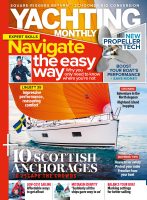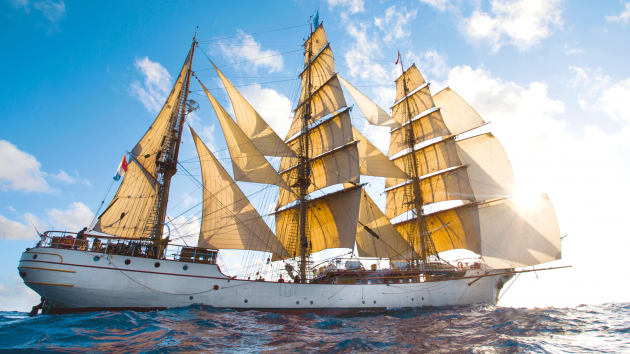With the drive to reduce carbon emissions, could high-end sailing tech be ushering in a new age of working sailing ships and square riggers? Ben Lowings investigates.
Most cruising yacht sailors would agree that any field of knowledge that might sharpen their own skills is worthwhile learning about. But does Patrick O’Brian rattling on about thimbles and cross-catharpings help you claw home across the Solent?
Square-rig men-o’-war and old windjammers are ghosts from the past. But a wave of excitement is washing over the cargo shipping industry. Square-rig – and the power it offers – is catching on.
FastWings or WindWings are some of the options. DynaRig, set up by Southern Spars for the superyachts Black Pearl and Maltese Falcon, is another. Canada-based Veer Group is planning to use this for its Design No.1. With electricity from hydrogen as its secondary power source, it’ll be the first clean oceangoing container ship.

Technology developed for superyachts such as the Maltese Falcon could pave the way for cleaner shipping and a rebirth of sail at sea. Photo: Stuart Pearce/Alamy Stock Photo
According to Danielle Southcott, Veer’s CEO and herself a tall ship master, all the sails on the three masts, each with five yards, can be set or taken in within six minutes. Winches on the yardarms drag out a boltrope to unfurl each sail, double-rolled on a single mandrel inside the mast.
Southcott goes on to explain how the entire rig – around 25,000 square feet (2,323m2) of sail – is operated by a single person by flick switches and buttons on a control panel.
‘It’s like a Game Boy console,’ she explains. ‘The masts are comparable to wind turbines. Very strong – they’re made from carbon fibre.’
The tall ship training school – the only one in the world, at Enkhuizen in the Netherlands – now offers a DynaRig course. The vision is of an entirely green fleet of ocean trading ships.
When I ask how realistically that could replace today’s merchant navy and its ever-increasing deadweight-tonnage sea miles, she explains how a great volume of today’s cargo is fossil fuel. An industry with a carbon footprint larger than Germany has been asked to overhaul itself: sailing ships don’t need to deliver fuel.
Article continues below…
Why I took my Ketch rigged yacht and turned it into a brigantine square-rigger
People have asked why I decided to change a perfectly good ketch into a staysail schooner? It’s a reasonable question.…
Sailing around 3,500 miles on the 1917 schooner Oosterschelde: Training in a time warp
I have always wanted to sail on a tall ship; to experience night watches on the high seas, to make…
Sailing with history on square riggers
The call has not yet gone out for legions of cruising yachtsmen and women to take over the bridges of the next-generation merchant shipping fleet, however. Technologies have already been merged. A combination of old and new can be seen on Tenacious, the barque until recently operated by the Jubilee Sailing Trust.
The yards work like in-mast furlers, with each sail winding up inside like a horizontal theatre curtain. Tenacious is designed for a mixed-ability crew. Wheelchairs can be taken aloft and visually impaired people can also go aloft to hand sails.

Going aloft to hand sail is a rite of passage for anyone who has sailed a square rigger. Photo: Ben Lowings
Best-placed to explain square-rig for cruising yachties might be the yachtswoman and tall ship sailor, Hannah Hurford. ‘Sailing Tall Ships is more physical,’ she argues. ‘You have more sails to work with, heavier rigs and usually a larger vessel. You’re more appreciative of what sailing used to be, what our bodies are capable of and the way the world once was.’
For Hurford, one of the benefits of switching between yachts and tall ships is a greater understanding of teamwork. The order of command in a larger crew also tends to be more rigid. ‘As the crew each have a specific role, it is clear who has the final word. That’s [not] a particularly bad thing to experience.’
Preserving the past
Of course most ships flying square sail also have versions of the fore-and-aft sails used on yachts. Hannah explains that the lines’ names and parts of the sail are the same, so this helps the transition.
For those interested in learning more, Hannah hosts a popular podcast Off Watch (www.offwatchpodcast.co.uk), along with fellow sailor Jess Clay at the Classic Sailing travel agency.

Tall ship Tenacious is uniquely equipped for disabled sailors, but her future is currently uncertain. Photo: Max Mudie / Alamy Stock Photo
Jess says square-rigs make one truly value how easy modern boats are to sail. For her, it’s about understanding in more depth ‘the challenges seafarers from yesteryear had. ‘If people are passionate sailors,’ says Jess, ‘there is a need… to help preserve traditional ships for future generations.’
And preservation is a live issue. At the time of writing this article, Tenacious was in dry dock in Sharpness, her fate to be decided by receivers.
Graham Strudwick, a spokesperson for the Save Tall Ship Tenacious campaign team, believes her loss is being felt very widely. He echoes Hannah Hurford’s point about teamwork.
‘You have to learn to do things together as a watch. In the watch up to half could be disabled. The Watch Leader has to quickly assess what [tasks] individuals are capable of to ensure maximum involvement whilst keeping people safe. As the voyage progresses the watch leader will have to reassess this as people’s skills and knowledge improves.’
Yacht crew on passage will be very familiar with the benefits of off-watch down-time, when people gel and become more supportive. Graham says his long voyages have left him with many friends in different parts of the world.
He lists the many readily transferable skills: ‘Sail handling, working the ropes, lookout duties, using electronic systems to monitor any ship movement whilst
at anchor, navigation using charts and electronic systems as well as sextant use and use of conversion table. Even simple things like “always one hand for the ship” and “three points of contact” while climbing the rigging.’
An America’s Cup and square rigger crossover
One would be hard pressed to see any commonality between the AC72 crews screaming around relatively flat inshore waters controlling sails with the push of a button, and bands of sinewy jack-tars hauling on their braces while singing a shanty.
These apparently irreconcilable opposites actually share a belief that good seamanship is at heart about communication between team members to form a cohesive entity.

America’s Cup crews have to communicate constantly to perform, much like the crews of every other sailing vessel. Photo: Neil Farrin / Alamy Stock Photo
Remember the America’s Cup helmet microphones on sticks and the constant chit-chat between them under the howl of the 50kn apparent wind and those groaning hydraulics heaving the giant foils?
In spirit, one could argue, it is little different from the team queuing up at the tallship main brace, the rhythms of the repetitive shanty interspersed with the whispers of adjustment or encouragement.
If there are ‘racers’, the ‘leisure cruising community’, the ‘old gaffers’, and the ‘tall ship sail training community’, as well as professional deck crew and officers on cargo ships, then it is as well to remember they are all one, united, ‘sailing community’.

Veer’s container vessels, fitted with RynaRig masts, are capable of carrying a large number of cargo containers. Photo: Veer
While modern yachts are a world apart from square riggers both old and new, it’s not inconceivable that a new era of working sail may be on the horizon.
The square rig
Square rig is not named for the boxy shape of most sails, but because the sails are raised across the vessel’s beam, athwart or ‘square’. Bermudan sloops can draw
their sails at an angle about 20 degrees closer to the wind direction than square-riggers.
Lines are (traditionally) sweated and hauled through belaying pins. Usually halyards go to a fife rail, a kind of three sided bench around the base of each mast. The lines for the lowest sails are foremost and lead aft as each sail is higher.
Furling sails or stowing (if you’re not using DynaRig) usually requires people aloft, on the yards, a little like securing the main to the boom on yachts
with no lazyjacks.
Most work is still done on deck. Topmen and women don’t have to drag the whole weight of the sail upwards to furl it. Ropes attached to the corners (clews), drawing up the belly (bunt) and side-edges (leeches) all get hauled in through the rails below by sailors standing firmly on the main deck.
Enjoyed reading this?
A subscription to Yachting Monthly magazine costs around 40% less than the cover price, so you can save money compared to buying single issues.
Print and digital editions are available through Magazines Direct – where you can also find the latest deals.
YM is packed with information to help you get the most from your time on the water.
-
-
- Take your seamanship to the next level with tips, advice and skills from our experts
- Impartial in-depth reviews of the latest yachts and equipment
- Cruising guides to help you reach those dream destinations
-
Follow us on Facebook, Twitter and Instagram.







